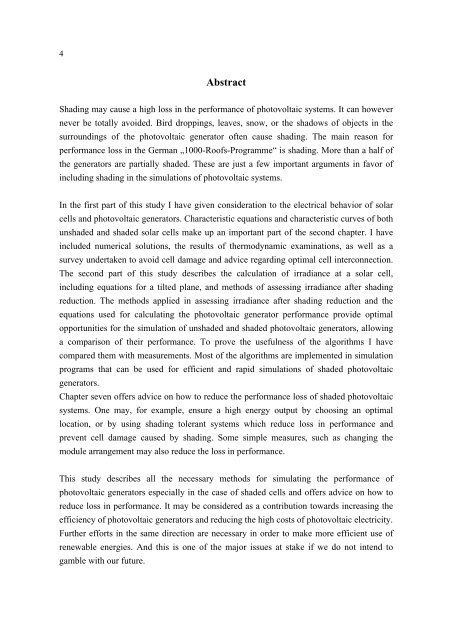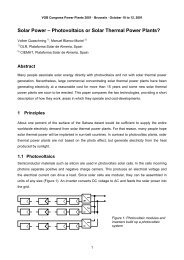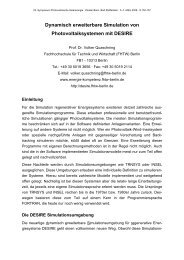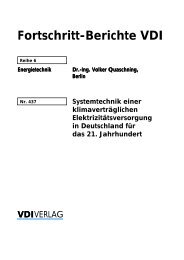Simulation der Abschattungsverluste bei solarelektrischen Systemen
Simulation der Abschattungsverluste bei solarelektrischen Systemen
Simulation der Abschattungsverluste bei solarelektrischen Systemen
- Keine Tags gefunden...
Erfolgreiche ePaper selbst erstellen
Machen Sie aus Ihren PDF Publikationen ein blätterbares Flipbook mit unserer einzigartigen Google optimierten e-Paper Software.
4AbstractShading may cause a high loss in the performance of photovoltaic systems. It can howevernever be totally avoided. Bird droppings, leaves, snow, or the shadows of objects in thesurroundings of the photovoltaic generator often cause shading. The main reason forperformance loss in the German „1000-Roofs-Programme“ is shading. More than a half ofthe generators are partially shaded. These are just a few important arguments in favor ofincluding shading in the simulations of photovoltaic systems.In the first part of this study I have given consi<strong>der</strong>ation to the electrical behavior of solarcells and photovoltaic generators. Characteristic equations and characteristic curves of bothunshaded and shaded solar cells make up an important part of the second chapter. I haveincluded numerical solutions, the results of thermodynamic examinations, as well as asurvey un<strong>der</strong>taken to avoid cell damage and advice regarding optimal cell interconnection.The second part of this study describes the calculation of irradiance at a solar cell,including equations for a tilted plane, and methods of assessing irradiance after shadingreduction. The methods applied in assessing irradiance after shading reduction and theequations used for calculating the photovoltaic generator performance provide optimalopportunities for the simulation of unshaded and shaded photovoltaic generators, allowinga comparison of their performance. To prove the usefulness of the algorithms I havecompared them with measurements. Most of the algorithms are implemented in simulationprograms that can be used for efficient and rapid simulations of shaded photovoltaicgenerators.Chapter seven offers advice on how to reduce the performance loss of shaded photovoltaicsystems. One may, for example, ensure a high energy output by choosing an optimallocation, or by using shading tolerant systems which reduce loss in performance andprevent cell damage caused by shading. Some simple measures, such as changing themodule arrangement may also reduce the loss in performance.This study describes all the necessary methods for simulating the performance ofphotovoltaic generators especially in the case of shaded cells and offers advice on how toreduce loss in performance. It may be consi<strong>der</strong>ed as a contribution towards increasing theefficiency of photovoltaic generators and reducing the high costs of photovoltaic electricity.Further efforts in the same direction are necessary in or<strong>der</strong> to make more efficient use ofrenewable energies. And this is one of the major issues at stake if we do not intend togamble with our future.









